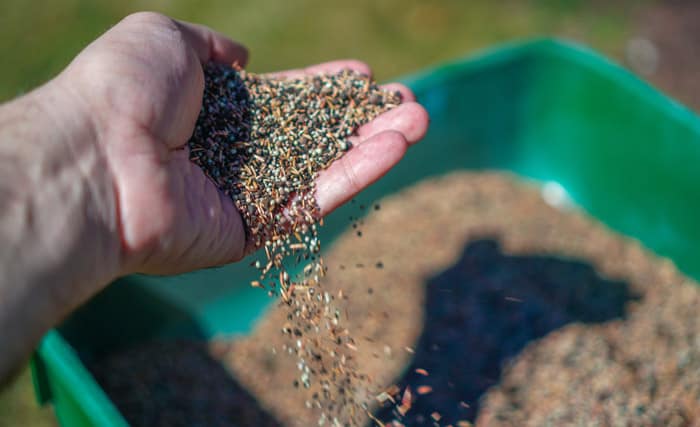How to Reseed a Lawn.
Maintain a healthy lawn and maximize curb appeal.
There are numerous reasons why you might want to reseed your lawn. From restoring a lawn that’s been taken over by weeds or infested with pests to fixing areas that experience heavy foot traffic or other damage, reseeding helps maintain a healthy lawn over the course of time. Those who want to maximize their curb appeal might even reseed before selling their home.
Depending on the size of your lawn, reseeding can be an arduous and time-consuming process. Smaller lawns can be finished with just a few hours of labor, but larger ones might require several morning and afternoon sessions to complete. In either case, you’ll need some basic tools before you get started:
- Rake
- Tiller
- Shovel
- Spreader
- Sod roller (optional)
You’ll also need some basic supplies, too.
- Grass seed
- Fertilizer
- Black plastic sheeting or herbicide
- Soil conditioner
Now that you have your tools and materials, it’s time to begin the reseeding process. It’s usually best to start with a limited area before trying to tackle your whole lawn. This is especially true for a beginner, as it lets you get started without having to worry about destroying your entire yard.
Testing the Soil
Before diving into the job with your rake and shovel, take some time to test your soil. Soil testing kits are rather inexpensive, usually costing less than $20, and they’ll make it easy to find the perfect fertilizers and soil conditioners for your new lawn. For best results, take samples from several different areas of your lawn.
Removing Weeds and Old Grass
The first step is to remove your old lawn – including any weeds. Weed killers and other forms of herbicide are a great option for those who don’t mind using chemicals on their lawn, just make sure to follow the directions and use the property safety precautions.
Alternatively, you can use black plastic sheeting to cover the entire lawn. Anchor it down at the corners with large rocks, sandbags, or bricks, and eventually the grass underneath will start to die and dry up. At that point, it’s easily raked up and removed from the remaining soil.
Clearing and Tilling Your Lawn
Now it’s time to clear the soil of any leftover debris. This includes old grass, weeds, roots, sticks, and rocks. You’ll primarily use your rake for this task, but your shovel will come in handy for removing larger rocks and filling in holes or ruts.
You can begin tilling once your soil is clear of all debris. Hand tillers are great for smaller lawns, but those with larger jobs might consider buying or renting a gas-powered or electric tiller. In either case, you’ll want to ensure your entire lawn has been tilled before proceeding to the next phase.
Conditioning the Soil
A healthy lawn begins with healthy soil. If you’ve already tested your soil, you should have a good idea of the kind of conditioners you’ll need. Some common options include:
- Manure
- Compost
- Lime
- Sulfur
- Gypsum
Once you’ve found the right conditioner for your soil, spread the product evenly over the surface. For best results, try to work the conditioner into the top four or five inches of dirt. This will be easier if your soil has been properly tilled beforehand.
Reseeding and Applying Fertilizer
Now it’s time for the actual reseeding process. A seed spreader will make short work of any job, regardless of size, but smaller lawns can be reseeded by hand if necessary. In either case, you should try to reseed your lawn on a day with minimal wind, as this will only result in wasted seed and a patchy lawn.
For best results, use your rake to dig little furrows – or trenches – across your lawn. After seeding, turn your rake upside down and use the flat side to secure your seed and bury it underneath a small layer of soil.
Apply your fertilizer immediately after spreading the new grass seed. Not only will this help them take root and germinate quicker, but it will help avoid damage caused by excess wind, heat, or rain.
In some cases, you might need to compact the soil with a sod roller. Avoid compacting the soil too much, however, as you could damage your lawn and make it harder for your new grass to grow.
Maintaining your New Lawn and When to Call Help.
Reseeded lawns should be watered at least twice per day for the first two weeks after reseeding, but those in warmer climates might want to water even more frequently than that. Once your lawn is approximately two weeks old, the watering cycle can be reduced to once every few days in most climates. But, what if you end up overwhelmed or don’t get the results you’re hoping to see? For many, it may not be worth the headache or chancing a bigger issue for your efforts. In that case, just reach out to us at lawncare.net, where you’ll find the Best Lawn Care Pros in the business – and your lawn will be on the way to a yard you can enjoy and show off!

